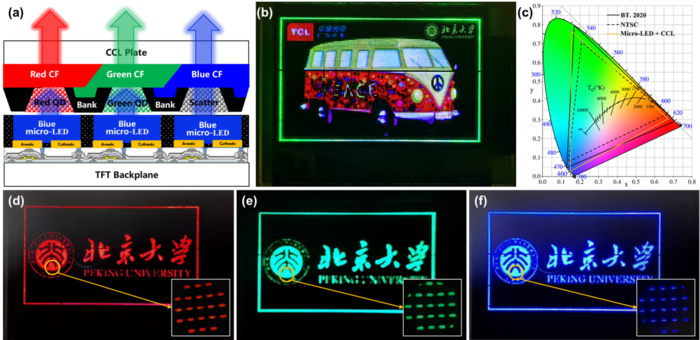LIGHT PUBLISHING CENTER, CHANGCHUN INSTITUTE OF OPTICS, FINE MECHANICS AND PHYSICS, CAS
Micrometre-scale light-emitting diode (micro-LED) displays have attracted significant interest owing to their exciting features, such as high brightness and contrast ratio, low power consumption, and prolonged lifetime. Nevertheless, some technical bottlenecks remain that should be resolved for the further advancement of this technology for mass production. In addition to the mass-transfer challenge, significant differences in electroluminescence (EL) efficiencies and the threshold voltages of red, green, and blue (RGB) LEDs inevitably complicate the driving circuit design of display panels. Furthermore, blue LEDs exhibit relatively better stability characteristics than their red and green counterparts, which can result in a high risk of colour shift after long-term usage. Therefore, alternative strategies should be explored to harness the full potential of micro-LED technology for high-performance full-colour displays. Therefore, blue micro-LEDs integrated with red and green colour conversion materials (CCMs) have recently emerged as an effective method of developing efficient full-colour displays. RGB emissions can be attained by combining phosphors or quantum dots (QDs) with ultraviolet (UV) or blue LEDs. In addition to the fine patterning of QD films as colour conversion layers (CCLs) for efficient and complete photoconversion, another major bottleneck is the crosstalk effect among adjacent pixels because of the wide view-angle feature of LED chips.

a) Schematic architecture of the top-emitting colour-converted full-colour micro-LED display prototype. (b) Vivid bus image; (d) red, (e) green, and (f) blue Peking University logos illuminated by this CCLs-integrated micro-LED display (The insets in d, e and f are the corresponding microscopic images of red, green, and blue pixels). (c) Color gamut of BT. 2020, NTSC standard, and our demonstrated module.
In a new paper published in Light Advanced Manufacturing, a team of scientists, led by Professor Hong Meng from School of Advanced Materials, Shenzhen Graduate School, Peking University, China, and co-workers focused on conventional top-emitting structure and systematically simulated the factors that contribute to the crosstalk effect and observed that filling the space between each micro-LED chip with a light-blocking matrix (LBM) can be a promising solution to alleviate this risk. Based on the simulation results, a black LBM matrix was finely moulded on the top-emitting blue micro-LED backlight through a moulding and plasma etching technique. With the black LBM, the view-angle of the backlight was reduced by 40° and the crosstalk effect was efficiently suppressed. Eventually, a full-colour display was manufactured by integrating an LBM-moulded blue micro-LED backlight with red and green QD CCLs. The colour gamut of our display prototype can reach as high as 122% of the NTSC.
The main challenge of this work is how to effectively introduce an LBM into micrometre-scale spaces between adjacent micro-LEDs. Meanwhile, the side emissions among adjacent blue micro-LEDs should be completely blocked, whereas the forward emissions should be maintained. These scientists summarize the manufacturing process of their panel:
“We proposed three schemes: press-assisted moulding, inkjet printing (IJP), and metal stencil printing (MSP). Based on the corresponding LBM materials for these three approaches (semi-solid gel, liquid ink, and paste state), we conducted three experiments to introduce the LBM into micro-LED panels. As demonstrated, the LBM was completely moulded inside the micro-LED spaces using the first approach. However, a “U” shape film morphology and rough patternswere achieved through the IJP and MSP methods. In the following, we focus on the moulding method to fabricate the LBM on micro-LEDs.”
“By employing a top-emitting backlight design with the space between each micro-LED chip filled with an LBM, the crosstalk effect between different pixels was efficiently alleviated. Compared with conventional micro-LED displays containing RGB LEDs, our developed display prototype offers significantly improved colour gamut values, as high as 122% NTSC or 91% BT.2020.” they added.
“This research provides an effective method for suppressing the crosstalk effect in top-emitting micro-LED-based displays. We anticipate that our proposed method will spur the further development of high-performance colour-converted full-colour micro-LED displays” the scientists forecast.
JOURNAL
Light: Advanced Manufacturing
DOI
|
If you would like to know more details , please contact:
|












